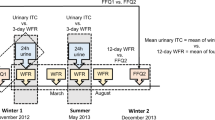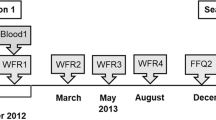Abstract
Objectives:
To measure the relationship between quercetin and naringenin intakes as estimated by food frequency questionnaire (FFQ), and the urinary excretion of quercetin and naringenin aglycones after their enzymatic hydrolysis in human volunteers.
Subjects and methods:
Volunteers were recruited via the Human Nutrition Unit volunteer databank at the Institute of Food Research, Norwich. Sixty-three volunteers were recruited into the study, of which 14 were excluded and 49 completed the study. A modified FFQ was developed and used to estimate daily intake of quercetin and naringenin in 49 healthy volunteers who also provided five 24-h urine samples over a 2-week period. Urinary excretion of quercetin and naringenin metabolites was determined by solid-phase extraction and high-pressure liquid chromatography.
Results:
The estimated mean intakes of quercetin and naringenin were 29.4 mg (s.d. 15.0) and 58.1 mg (s.d. 62.7) per day, respectively. Mean urinary excretion of quercetin was 60.1 μg (s.d. 33.1) and that of naringenin was 0.56 mg (s.d. 0.4). The correlation between FFQ estimated intake of quercetin and naringenin and levels excreted in the urine were r=0.82 (P<0.0001) and r=0.25 (P=0.05), respectively.
Conclusions:
We observed a statistically significant correlation between the urinary excretion of quercetin and naringenin metabolites and their dietary intake as estimated by FFQ. Use of FFQs in epidemiological studies requiring an estimate of flavonoid intake seems justified.
This is a preview of subscription content, access via your institution
Access options
Subscribe to this journal
Receive 12 print issues and online access
$259.00 per year
only $21.58 per issue
Buy this article
- Purchase on Springer Link
- Instant access to full article PDF
Prices may be subject to local taxes which are calculated during checkout




Similar content being viewed by others
References
Adlercreutz H, Mousavi Y, Clark J, Hockerstedt K, Hamalainen E, Wahala K et al. (1992). Dietary phytoestrogens and cancer in vitro and in vivo studies. J Steroid Biochem Mol Biol 41, 331–337.
Arts CW, Hollman PC (2005). Polyphenols and disease risk in epidemiologic studies. Am J Clin Nutr 81 (Suppl 1), 317S–325S.
Block G (1998). Human dietary assessment: methods issues. Prev Med 18, 653–660.
Block G, Hartman AM (1989). Issues in reproducibility and validity of dietary studies. Am J Clin Nutr 50 (Suppl), 51133–51138.
Briefel RR, Flegal KM, Winn DM, Loria CM, Johnson CL, Sempos CT (1992). Assessing the nation's diet: limitations of the food frequency questionnaire. J Am Diet Assoc 92, 959–962.
Brunner E, Stallone D, Juneja M, Bingham S, Marmot M (2001). Dietary assessment in Whitehall II: comparison of 7 d diet diary and food-frequency questionnaire and validity against biomarkers. Br J Nutr 86, 405–414.
Clapp JA, McPherson RS, Reed DB, Hsi BP (1991). Comparison of a food frequency questionnaire using reported vs standard portion sizes for classifying individuals according to nutrient intake. J Am Diet Assoc 91, 316–320.
Crawford PB, Obarzanek E, Morrison J, Sabry ZI (1994). Comparative advantage of 3-day food records over 24-hour recall and 5-day food frequency validated by observation of 9- and 10-year-old girls. J Am Diet Assoc 94, 626–630.
Crespy V, Morand C, Besson C, Manach C, Demigne C, Remesy C (2002). Quercetin, but not its glycosides, is absorbed from the rat stomach. J Agric Food Chem 50, 618–621.
Day N, McKeown N, Wong M, Welch A, Bingham S (2001). Epidemiological assessment of diet: a comparison of a 7-day diary with a food frequency questionnaire using urinary markers of nitrogen, potassium and sodium. Int J Epidemiol 30, 309–317.
de Vries JH, Hollman PC, Meyboom S, Buysman MN, Zock PL, van Staveren WA et al (1998). Plasma concentrations and urinary excretion of the antioxidant flavonols quercetin and kaempferol as biomarkers for dietary intake. Am J Clin Nutr 68, 60–65.
DuPont MS, Bennett RN, Mellon FA, Williamson G (2002). Polyphenols from alcoholic apple cider are absorbed, metabolized and excreted by humans. J Nutr 132, 172–175.
DuPont MS, Day AJ, Bennett RN, Mellon FA, Kroon PA (2004). Absorption of kaempferol from endive, a source of kaempferol-3-glucuronide, in humans. Eur J Clin Nutr 58, 947–954.
Erlund I, Meririnne E, Alfthan G, Aro A (2001). Plasma kinetics and urinary excretion of the flavanones naringenin and hesperetin in humans after ingestion of orange juice and grapefruit juice. J Nutr 131, 235–241.
Gao YT, McLaughlin JK, Blot WJ, Ji BT, Dai Q, Fraumeni Jr JF (1994). Reduced risk of esophageal cancer associated with green tea consumption. J Natl Cancer Inst 86, 855–858.
Gee JM, Watson M, Matthew JA (1999). Consumption of fish oil leads to prompt incorporation of eicosapentaenoic acid into colonic mucosa of patients prior to surgery for colorectal cancer, but has no detectable effect on epithelial cytokinetics. J Nutr 129, 1862–1865.
Hollman PC, van Trijp JM, Buysman MN, van der Gaag MS, Mengelers MJ, de Vries JH et al (1997). Relative bioavailability of the antioxidant flavonoid quercetin from various foods in man. FEBS Lett 418, 152–156.
Ishii K, Furuta T, Kasuya Y (2000). Mass spectrometric identification and high performance liquid chromatographic determination of a flavonoid glycoside naringinine in human urine. J Agric Food Chem 48, 56–59.
Knekt P, Jarvinen R, Seppanen R, Hellovaara M, Teppo L, Pukkala E et al. (1997). Dietary flavonoids and the risk of lung cancer and other malignant neoplasms. Am J Epidemiol 146, 223–230.
Larkin FA, Metzner HL, Thompson FE, Flegal KM, Guire KE (1989). Comparison of estimated nutrient intakes by food frequency and dietary records in adults. J Am Diet Assoc 89, 215–223.
Le Marchand L, Murphy SP, Hankin JH, Wilkens LR, Kolonel LN (2000). Intake of flavonoids and lung cancer. J Natl Cancer Inst 92, 154–160.
Lin J, Zhang SM, Wu K, Willett WC, Fuchs CS, Giovannucci E (2006). Flavonoid intake and colorectal cancer risk in men and women. Am J Epidemiol 164, 644–651.
Lloyd HM, Paisley CM, Mela DJ (1993). Changing to a low fat diet: attitudes and beliefs of UK consumers. Eur J Clin Nutr 347, 361–373.
Manach C, Scalbert A, Morand C, Remesy C, Jimenez L (2004). Polyphenols: food sources and bioavailability. Am J Clin Nutr 79, 727–747.
Manach C, Scalbert A, Morand C, Remesy C, Jimenez L (2005). Bioavailability and bioefficacy of polyphenols in humans. Review of 97 bioavailability studies. Am J Clin Nutr 81 (Supp 1), 230S–242S.
Manach C, Morand C, Gil-Izquierdo A, Bouteloup-Demange C, Remesy C (2003). Bioavailability in humans of the flavanones hesperidin and narirutin after the ingestion of two doses of orange juice. Eur J Clin Nutr 57, 235–242.
McCance RA, Widdowson EM (2002). The Composition of Foods. 6th Summary Edition. Foods Standards Agency: Cambridge.
Michels KB, Bingham SA, Luben R, Welch AA, Day NE (2004). The effect of correlated measurement error in multivariate models of diet. Am J Epidemiol 60, 59–67.
Newby PK, Hu FB, Rimm EB, Smith-Warner SA, Feskanich D, Sampson L et al (2003). Reproducibility and validity of the Diet Quality Index Revised as assessed by use of a food-frequency questionnaire. Am J Clin Nutr 78, 941–949.
Nielsen SE, Freese R, Kleemola P, Mutanen M (2002). Flavonoids in human urine as biomarkers for intake of fruits and vegetables. Cancer Epidemiol Biomarkers Prev 11, 459–466.
Nijveldt RJ, van Nood E, van Hoorn DE, Boelens PG, van Norren K, van Leeuwen PA (2001). Flavonoids: a review of probable mechanisms of action and potential applications. Am J Clin Nutr 74, 418–425.
Noethlings U, Hoffmann K, Bergmann MM, Boeing H (2003). Portion size adds limited information on variance in food intake of participants in the EPIC-Potsdam Study. J Nutr 133, 510–515.
Resnicow K, Odom E, Wang T, Dudley WN, Mitchell D, Vaughan R et al (2000). Validation of three food frequency questionnaires and 24-h recalls with serum carotenoid levels in a sample of African-American adults. Am J Epidemiol 152, 1072–1080.
Scalbert A, Williamson G (2000). Dietary intake and bioavailability of polyphenols. J Nutr 130, 2073S–2085S.
Subar AF, Thompson FE, Smith AF, Jobe JB, Ziegler RG, Potischman N et al (1995). Improving food frequency questionnaires: a qualitative approach using cognitive interviewing. J Am Diet Assoc 95, 781–788.
Subar AF, Ziegler RG, Thompson FE, Johnson CC, Weissfeld JL, Reding D, Kavounis KH, et al., Prostate, Lung, Colorectal, and Ovarian Cancer Screening Trial Investigators (2001). Is shorter always better? Relative importance of questionnaire length and cognitive ease on response rates and data quality for two dietary questionnaires. Am J Epidemiol 53, 404–409.
Sun CL, Yuan JM, Lee MJ, Yang CS, Gao YT, Ross RK et al. (2002). Urinary tea polyphenols in relation to gastric and esophageal cancers: a prospective study of men in Shanghai, China. Carcinogenesis 23, 1497–1503.
Thompson FE, Byers T (1994). Dietary assessment resource manual. J Nutr 124 (Suppl), 112245S–112317S.
Tjonneland A, Haraldsdottir J, Overvad K, Stripp C, Ewertz M, Jensen OM (1992). Influence of individually estimated portion size data on the validity of a semiquantitative food frequency questionnaire. Int J Epidemiol 21, 770–777.
United States Department of Agriculture (2006). Database for the Flavonoid Content of Selected Foods. Version Current 2 August. Internet:http://www.nal.usda.gov/fnic/foodcomp/Data/Flav/Flav02.pdf(accessed 14th November 2006).
Warneke CL, Davis M, De Moor C, Baranowski T (2001). A 7-item versus 31-item food frequency questionnaire for measuring fruit, juice, and vegetable intake among a predominantly African-American population. J Am Diet Assoc 101, 774–779.
Willett WC (1998). Nutritional Epidemiology 2nd ed Oxford University Press: New York.
Willett WC, Stampfer MJ, Colditz GA, Rosner BA, Hennekens CH, Speizer FE (1987). Dietary fat and the risk of breast cancer. New Engl J Med 316, 22–28.
Young JF, Nielsen SE, Haraldsdottir J, Daneshvar B, Lauridsen ST, Knuthsen P et al. (1999). Effect of fruit juice intake on urinary quercetin excretion and biomarkers of antioxidative status. Am J Clin Nutr 69, 87–94.
Acknowledgements
This work was supported by a grant from the ‘BigC’ cancer charity, Norwich, UK and partly by the Core Strategic Grant of the BBSRC. SR was employed as a Medical Officer at the BUPA Hospital, Norwich.
Author information
Authors and Affiliations
Corresponding author
Additional information
Contributors: SR is principal investigator who coordinated and performed the study and drafted the manuscript, JMG is co-investigator who assisted in the formulation of the modified FFQ and helped in drafting the manuscript, LB developed software in Microsoft Access to extract and process information on nutrients and non-nutrients from the FFQ, GB is co-investigator who assisted the principal investigator in developing the method for quercetin and naringenin extraction, SS is co-investigator who assisted the principal investigator in developing the method for quercetin and naringenin extraction, PK is co-investigator who assisted the principal investigator in developing the method for quercetin and naringenin extraction and helped in drafting the manuscript, JS is statistician who helped in extracting the data from the FFQ and perform statistical analysis on the data in STATA 8.3 SE, ARH, is supervisor who planned the study and helped in drafting the manuscript, AC is supervisor who monitored the study and helped in drafting the manuscript, MR is supervisor who monitored the study and helped in drafting the manuscript, ITJ is chief investigator and supervisor who planned and monitored the study, and co-wrote the manuscript.
Rights and permissions
About this article
Cite this article
Ranka, S., Gee, J., Biro, L. et al. Development of a food frequency questionnaire for the assessment of quercetin and naringenin intake. Eur J Clin Nutr 62, 1131–1138 (2008). https://doi.org/10.1038/sj.ejcn.1602827
Received:
Revised:
Accepted:
Published:
Issue Date:
DOI: https://doi.org/10.1038/sj.ejcn.1602827
Keywords
This article is cited by
-
Ethnic differences in grains consumption and their contribution to intake of B-vitamins: results of the Multiethnic Cohort Study
Nutrition Journal (2013)
-
Validation of a food frequency questionnaire to measure intakes of inulin and oligofructose
European Journal of Clinical Nutrition (2011)
-
Dietary inhibitors of monoamine oxidase A
Journal of Neural Transmission (2011)



